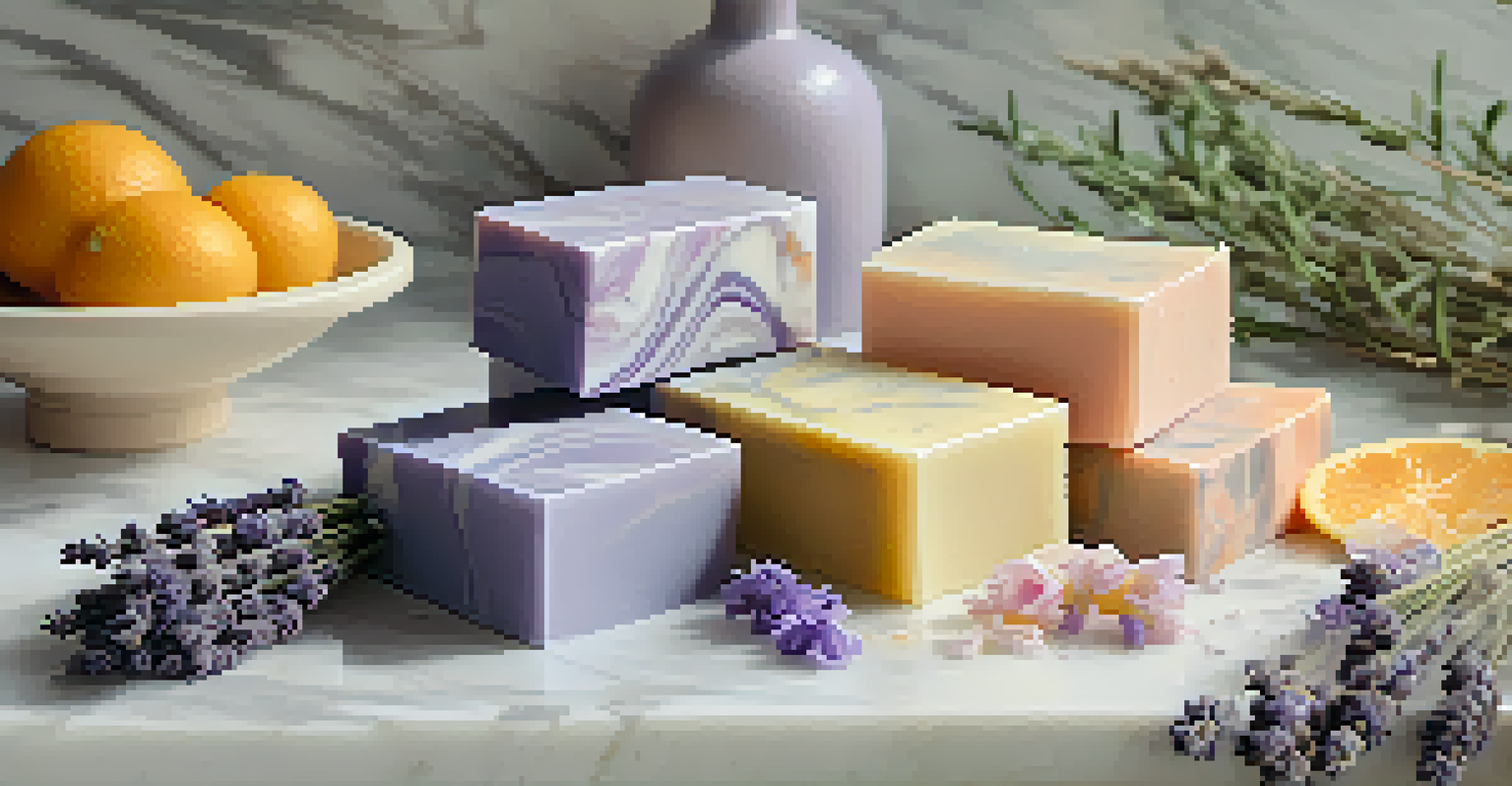The Art of Scent Blending: Creating Signature Soap Fragrances

Understanding the Basics of Fragrance Oils
To start your scent blending journey, it's essential to know the basics of fragrance oils. These concentrated liquids capture the essence of various scents, ranging from florals to spices. Understanding the different categories helps in creating well-balanced fragrances, ensuring that no single note overpowers the others.
Fragrance is the voice of inanimate things.
Fragrance oils can be categorized into top, middle, and base notes. Top notes are the initial scents you smell, while middle notes emerge after the top notes fade, creating a fuller aroma. Base notes provide depth and longevity to the fragrance, anchoring the lighter notes and giving your soap a lasting scent.
By familiarizing yourself with these categories, you can make informed decisions when selecting oils for your signature soap. It’s like composing a symphony—each note plays a vital role in creating a harmonious blend that delights the senses.
Choosing Your Signature Scent Profile
Choosing a signature scent profile is akin to finding your personal style. Think about the scents that resonate with you—whether it's the freshness of citrus or the warmth of vanilla. This personal connection will guide your blending process and make your creations truly unique.

Consider the mood or atmosphere you want to evoke with your soap. Different scents can stir emotions or memories; for instance, lavender can promote relaxation, while peppermint might invigorate. By aligning your fragrance choices with a desired emotional response, you can create a more meaningful product.
Understanding Fragrance Oil Basics
Familiarizing yourself with top, middle, and base notes is essential for creating well-balanced and harmonious soap fragrances.
Don’t hesitate to experiment with combinations that reflect your personality or brand identity. Just like fashion, scent blending allows for individual expression and creativity, making each soap a distinctive piece of art.
The Importance of Balance in Scents
Achieving balance in your scent blend is crucial for creating an appealing fragrance. Too much of one note can easily overpower the others, leading to a less harmonious result. Strive for a blend where each note complements, rather than competes with, the others.
Perfume is the most intense form of memory.
A useful method is to start with a ratio system, such as 3:2:1 for top, middle, and base notes. This approach helps ensure that the fragrance evolves beautifully over time, allowing each layer to shine in its moment. It’s like cooking—finding the right balance of ingredients can elevate a dish from ordinary to extraordinary.
Regularly test your blends to see how they interact with each other when mixed. This practice helps you fine-tune your recipe, leading to a signature scent that is not only unique but also well-rounded.
Experimenting with Different Combinations
Experimentation is at the heart of scent blending. Don’t shy away from trying unexpected combinations; you may discover a delightful pairing you never considered. For instance, mixing earthy sandalwood with fresh citrus can create an intriguing contrast that captivates the senses.
Keep a scent journal to document your experiments. Jot down the ratios and results of each blend, noting what works and what doesn’t. This record will serve as a valuable reference for future creations, allowing you to refine your blending skills over time.
Experimentation is Key
Trying unexpected scent combinations and keeping a scent journal can lead to unique and captivating fragrances.
Remember, some of the best fragrances come from trial and error. Embrace the process and enjoy the journey of creating something that reflects your vision and creativity.
Scent Layering Techniques for Complexity
Scent layering is a technique that adds depth and complexity to your soap fragrances. By layering different scents, you can create a multi-dimensional experience that unfolds over time. Think of it like painting a canvas—each layer adds richness and texture to the final piece.
To layer scents effectively, start with a base note and gradually add middle and top notes. This method allows you to gauge how each note interacts with the others as you build your fragrance. It’s a gradual process that can lead to stunning, intricate results.
Experimenting with layering can also help you understand how fragrances evolve during the soap-making process. This knowledge will empower you to craft blends that not only smell great but also maintain their integrity after curing.
Testing Your Soap Fragrances
Once you've crafted your scent, it's time to put it to the test. Testing your soap fragrances is crucial to ensure they perform well in the final product. Remember, the scent can change once it's mixed with the soap base and during the curing process.
Consider making small test batches to evaluate how the fragrance holds up. This allows you to see how the scent evolves over time and whether it meets your expectations. It’s like a dress rehearsal before the big show—ensuring everything is perfect before the final presentation.
Testing for Perfection
Testing small batches of your soap fragrances helps ensure they perform well and meet your expectations before finalizing.
Keep in mind that even the best blends might need adjustments after testing. Be open to tweaking your formulas to achieve the desired outcome, and don’t be afraid to revisit your scent journal for inspiration.
Finalizing Your Signature Soap Fragrance
Finalizing your signature soap fragrance is an exciting moment in the creative process. After testing and refining your blends, you’ll want to nail down the perfect recipe that embodies your vision. This is your chance to create a lasting impression with your soap.
Consider the branding aspect as well. Your fragrance should not only resonate with you but also appeal to your target audience. Think about how your soap scent can align with your brand values and identity, making it a cohesive part of your overall offering.

Once you’ve settled on your final blend, document the exact ratios and techniques used. This will help you replicate your signature fragrance in future batches, ensuring that your unique scents continue to delight customers and stand the test of time.